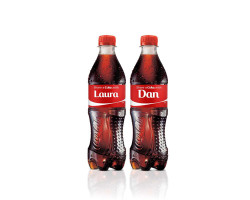Is it time for Build-Your-Own brochures, asks Neil Georgeson. He examines new software that can transform the hefty college prospectus, streamlining it into a document that is simply personalised.
Coca Cola’s recent ‘share a Coke’ campaign is often held up as a landmark in personalisation. If you remember, the drinks giant swapped its famous logo on its bottles for over a thousand first names to deliver one of the most successful marketing gimmicks of all time, boosting US sales of the product for the first time in over a decade.
 But was this true personalisation? After all, the drinks inside the bottles were all the same. The famous secret recipe remained intact – not refined to our own individual tastes, or to those of the person named on the bottle.
But was this true personalisation? After all, the drinks inside the bottles were all the same. The famous secret recipe remained intact – not refined to our own individual tastes, or to those of the person named on the bottle.
You see, thanks to our digital experiences, we’ve all grown rather sophisticated in our personalisation demands. Thanks to big data and complex algorithms, we’ve grown used to online advertisers targeting – and tempting – us with the holiday we almost booked or the shoes we almost bought as we browse online. We accept that online advertisers and marketers are beginning to understand our tastes and needs better than we do ourselves.
So I find it surprising that marketing collateral, whether electronic or hard copy, is still in ‘one size fits all’ mode. Prospective customers still have to wade their way through reams of irrelevant information before reaching the parts they need and, because of this, are likely to go elsewhere. And yet, of course it’s impossible to justify the cost of short, personalised runs.
Those responsible for marketing universities and colleges are particularly susceptible to this problem. Academic prospectuses are invariably huge and heavy, bringing together the entire programme from across the whole organisation. They take an exceptional amount of time and money to put together, to proof, to print and, particularly, to distribute.
Yet, they have to be prepared so far in advance that inevitably they become out-of-date as soon as they go to print. Course offerings update, curriculum content changes, and subjects go in and out of fashion. Additionally, if the full publication is online, prospective students or customers still have to scroll through material which is completely irrelevant to their course or needs. Why would a potential astrophysicist from Toronto want to wade through the finer details of a module on Middle English before they find the information they need?
It’s often the same for marketing brochures – products are often on a completely different stage of their lifecycle to a marketing campaign. They can become discontinued just as the brochure is delivered because of external market forces. There’s no time or opportunity to adapt. Customers find it difficult to find what they want and turn to a competitor instead.
Prospectus personalisation
Now new methods coming on to the market look set to bring prospectuses, brochures and catalogues of this kind into the era of personalisation. The software runs either as an embedded set of Java tools on a website or accessible through an iFrame and allows visitors to the site to drive the inclusion of specific content selected from the web page within design templates and standards. In other words, they can put together their own document, prospectus or brochure which is then emailed to them almost instantaneously. This can be followed up by a hard copy through the post where appropriate. The marketing journey continues way after the initial enquiry.
It’s easy to recognise the cost and time benefits. Also, the sooner the prospect (whether a student or customer) receives the information, the quicker they are likely to make a decision to buy or apply. But there are further advantages, too. Both inbound and outbound data can be integrated with a CRM or other database to ensure the system ‘knows’ about each inquiry. Where relevant, these prospects can then be followed up with reminders, special offers or appropriate news. In this way, the data gathered forms the foundations of an ongoing relationship, with all the up-sell and cross-sell opportunities this presents.
The data will also prove a valuable source of intelligence as to what content is preferred and how users compile their own selection of information, so organisations can be proactive in real-time to maximise opportunities or address problems.
Whether it’s seen as a way of addressing our need for individualism in a world of mass culture, or of dramatically cutting costs, time and storage needs; this type of customisation makes sense all round. New applications for the technology are being discovered all the time – the age of personalisation is only just beginning.


 But was this true personalisation? After all, the drinks inside the bottles were all the same. The famous secret recipe remained intact – not refined to our own individual tastes, or to those of the person named on the bottle.
But was this true personalisation? After all, the drinks inside the bottles were all the same. The famous secret recipe remained intact – not refined to our own individual tastes, or to those of the person named on the bottle.



Leave your thoughts